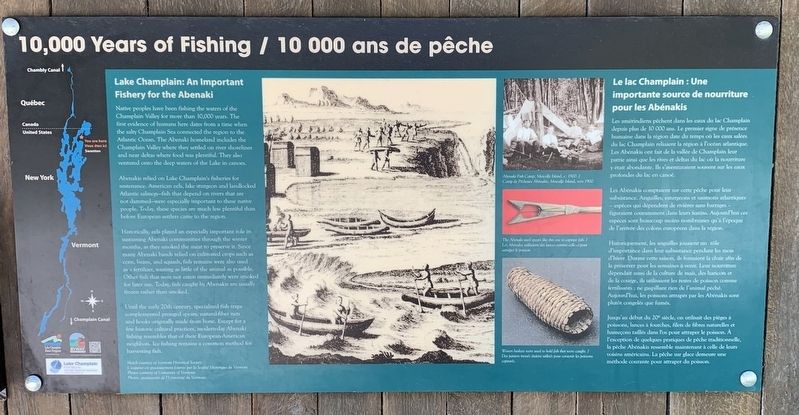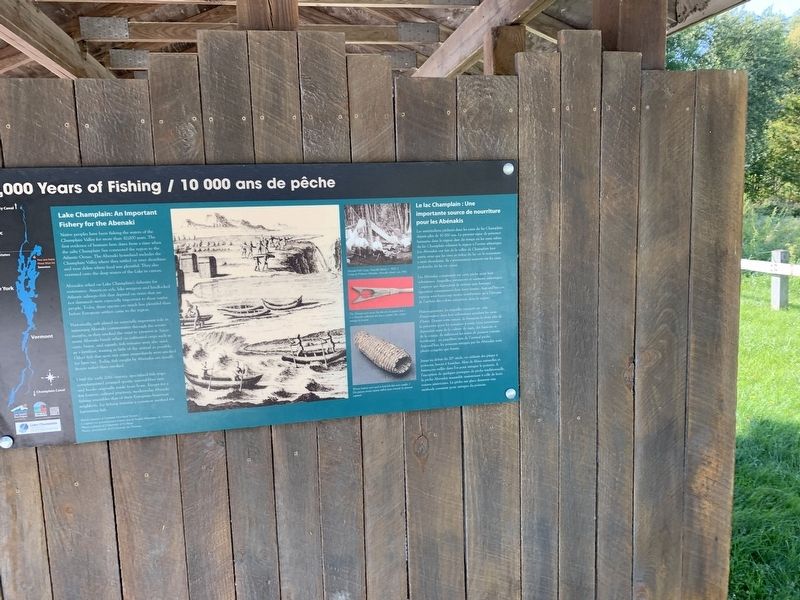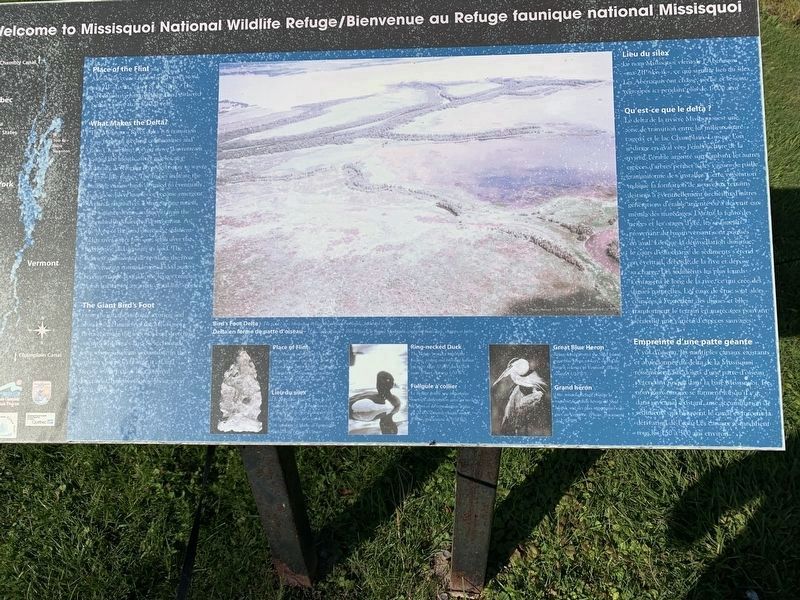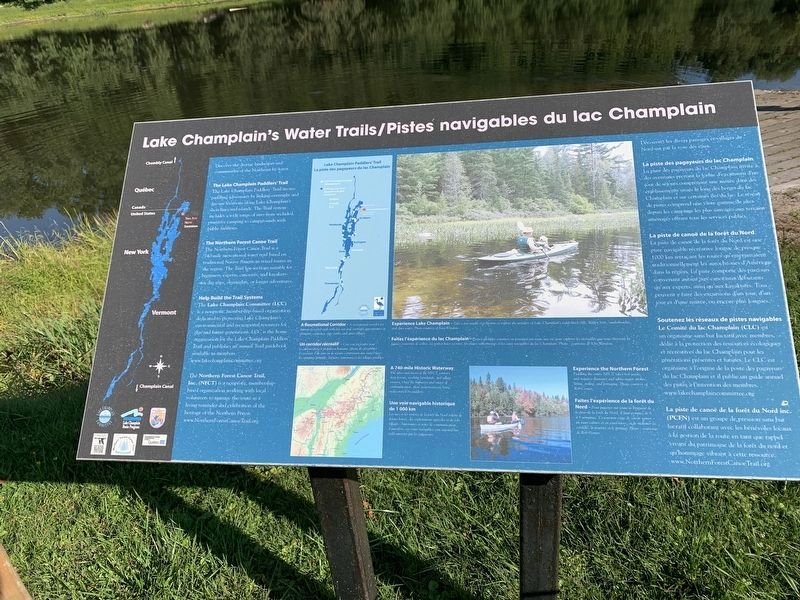Near Swanton in Franklin County, Vermont — The American Northeast (New England)
10,000 Years of Fishing / 10 000 ans de pêche
Lake Champlain: An Important Fishery for the Abenaki
Native peoples have been fishing the waters of the Champlain Valley for more than 10,000 years. The first evidence of humans here dates from a time when the salty Champlain Sea connected the region to the Atlantic Ocean. The Abenaki homeland includes the Champlain Valley where they settled on river shorelines and near deltas where food was plentiful. They also ventured onto the deep waters of the Lake in canoes.
Abenakis relied on Lake Champlain's fisheries for sustenance. American eels, lake sturgeon and landlocked Atlantic salmon-fish that depend on rivers that are not dammed-were especially important to these native people.Today, these species are much less plentiful than before European settlers came to the region.
Historically, eels played an especially important role in sustaining Abenaki communities through the winter months, as they smoked the meat to preserve it. Since many Abenaki bands relied on cultivated crops such as corn, beans, and squash, fish remains were also used as a fertilizer, wasting as little of the animal Other fish that were not eaten immediately were smoked for later use. Today, fish caught by Abenakis are usually frozen rather than smoked.
Until the early 20th century, specialized fish traps complemented pronged spears, natural-fiber nets and hooks originally made from bone. Except for a few historic cultural practices, modern-day Abenaki fishing resembles that of their European-American neighbors. Ice fishing remains a common method for harvesting fish.
Les amérindiens péchent dans les eaux du lac Champlain depuis plus de 10 000 ans. Le premier signe de présence humaine dans la région date du temps où les eaux salées du lac Champlain reliaient la région à l'océan atlantique. Les Abénakis ont fait de la vallée de Champlain leur patrie ainsi que les rives et deltas du lac où la nourriture y était abondante. Ils s'aventuraient souvent sur les eaux profondes du lac en canoë.
Les Abénakis comptaient sur cette pêche pour leur subsistance. Anguilles, esturgeons et saumons atlantiques -espèces qui dépendent de rivières sans barrages-figuraient couramment dans leurs festins. Aujourd'hui ces espèces sont beaucoup moins nombreuses qu'à l'époque de l'arrivée des colons européens dans la région.
Historiquement, les anguilles jouaient un rôle d'importance dans leur subsistance pendant les mois d'hiver. Durant cette saison, ils fumaient la chair afin de la préserver pour les semaines à venir. Leur nourriture dépendait aussi de la culture de mais, des haricots et de la courge, ils utilisaient les restes de poisson comme fertilisants ; ne gaspillant rien de l'animal péché. Aujourd'hui, les poissons attrapés par les Abénakis sont plutot congelés que fumés.
Jusqu'au début du 20e siècle, poissons, lances à fourches, filets de fibres naturelles et hameçons taillés dans l'os pour attraper le poisson. A l'exception de quelques pratiques de pêche traditionnelle, la pêche Abénakis ressemble maintenant à celle de leurs voisins américains. La pêche sur glace demeure une méthode courante pour attraper du poisson.
Abenaka Fish Camp, Metcalfe Island, c. 1900. / Camp de Pecheas Abénakis, Metcalfe Island, vers 1900
The Abenaki used spears like this one to capture fish/ Les Abénakis utilisaient des lances comme celle-di pour attraper le poisson.
Woven baskets were used to hold fish that were caught. / Des paniers tressés étaient utilisés pour contenir les poissons capams
Erected by Lake Champlain International, Lake Champlain Basin Program, Lake Champlain Byway.
Topics. This historical marker is listed in these topic lists: Animals • Anthropology & Archaeology • Native Americans. A significant historical year for this entry is 1900.
Location. 44° 57.517′ N, 73° 9.985′ W. Marker is near Swanton, Vermont, in Franklin County. Marker can be reached from Vermont Route 78, on the left when traveling east. Marker is at the boat launch. Touch for map. Marker is in this post office area: Swanton VT 05488, United States of America. Touch for directions.
Other nearby markers. At least 8 other markers are within 7 miles of this marker, measured as the crow flies. First People of the Missisquoi Delta (approx. 1.2 miles away); Missisquoi Village and Mission (approx. 2.9 miles away); The Bohannon Site (approx. 3.3 miles away); Saxe's Mills (approx. 5½ miles away); Highgate Falls Lenticular Truss Bridge (approx. 6 miles away); The International Boundary is Settled / La frontière internationale est définie (approx. 6.6 miles away); Missile Site (approx. 6.6 miles away); Historic Lake Islands - Samuel De Champlain (approx. 6.6 miles away). Touch for a list and map of all markers in Swanton.
Credits. This page was last revised on March 19, 2024. It was originally submitted on September 23, 2019, by Steve Stoessel of Niskayuna, New York. This page has been viewed 248 times since then and 34 times this year. Photos: 1, 2, 3, 4. submitted on September 23, 2019, by Steve Stoessel of Niskayuna, New York. • Andrew Ruppenstein was the editor who published this page.



